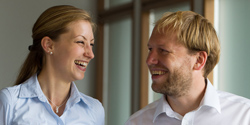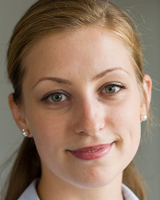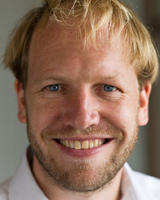To Swing or Not to Swing
Sebastian Sager, head of the junior research group for mathematical optimisation at the Heidelberg Graduate School of Mathematical and Computational Methods for the Sciences (HGS MathComp) and PhD student Anamaria Bodea meet regularly in the “Common Room” of the Interdisciplinary Center for Scientific Computing (IWR). Sitting at a curved bar, between café tables, sofas, a flat screen TV and a table football set, it's easy to strike up a conversation.
Doesn't this atmosphere keep you from doing research? Sebastian Sager On the contrary. The IWR thrives on exchange. There are 550 staff members, and someone always seems to have guests. We receive them here - and when we're alone, this is the perfect place to get creative without pressure and to develop a team spirit.

What do you talk about when you meet here?
Anamaria Bodea Sebastian is my mentor; we meet at least once a month. My PhD advisors Willi Jäger and Hans Georg Bock I see less often, usually only when I have results - Sebastian helps me with details, too.
Sager A lot of times we don't even talk about mathematics, but discuss if there's an upcoming publication or if it would make sense for Anamaria to go to a certain conference. And we define milestones for her doctoral thesis. We want to keep our PhD students from hitting a wall.
But aren't errors and detours part of the growth process for a scientist?
Sager We want to train scientists for leading positions at universities or in business. Our people should have a wide range of skills, but they should keep their ultimate goal in mind.
Bodea For the compact courses proposed by the Graduate School, students can decide for themselves if they want to attend courses that are specific to their own subject or check out new subjects. I learned an essential method for my work in a course on numerics. Also, the insights into project and time management or the job application training were really helpful, even though they had little to do with my research.
In their quest for more efficiency, Sebastian Sager's colleagues leave no stone unturned. One PhD student is trying to improve dosage plans for chemotherapy. Another one uses optimisation to predict the price development of various raw materials. Some group mem- bers cooperate with industrial partners to develop algorithms, e.g. for energy-efficient and time-optimised propulsion systems. Others work with psychologists on questions of decision theory - in experiments on complex decision processes, they find out what would have been the perfect solution of a game and where a test person made mistakes.
Mr Sager, what do all these research topics have in common?
Sager More than you'd think at first glance. From a mathematical standpoint, the issue is always to optimise an objective function under certain side conditions. We develop generic algorithms that help every PhD student in the group.
How do you find your research topics?
Sager Often people approach us. For example, Eberhard Scholz, a Heidelberg cardiologist, told us that a certain ECG pattern frequently leads to wrong diagnoses of cardiac patients. Even experienced doctors are often unable to tell if what they see is an atrial flutter or a secondary tachycardia following an operation. We mathematicians see this as an inverse problem and try to find out how we can more reliably arrive at the original signal.
Saving raw materials seems to be a central theme of your projects.
Sager There is a catchy slogan that says optimisation is the “science of better”. Processes become more efficient, safer, less expensive - these days, crash tests for cars are simulated on a computer. But increasingly, our methods are used to describe a system in the first place - when we work with biologists to examine processes in cells, for instance.
Ms Bodea, what's your system of choice?
Bodea Ultimately, I want to find out how electricity can become less expensive. I'm investigating a certain form of contract between power plant operators and electricity suppliers: the “swing options”. They're agreements that give electricity suppliers a limited number of rights to buy electricity within a fixed time period at the market price. These “swing options” can be mathematically optimised to allow the supplier to exercise this option at the most favourable time - and to buy the ideal quantity.
Why does a mathematician have to solve this problem?
Bodea The price of electricity shows strong seasonal fluctuations and can spike suddenly. I've developed a stochastic model that can reliably simulate the spot price as well as the direction of the price spikes. Based on this information, we can use numerical methods to find the best strategy for exercising the purchase options. For electricity suppliers, the main question with these contracts is always: to swing or not to swing?
You studied theoretical mathematics. What made to decide to focus on the electricity market?
Bodea I was interested in financial mathematics. That's why Professor Jäger suggested commodities as a topic. So I did some preliminary reading and met with a few experts. The Graduate School allows us to invite the best experts in our chosen field to give lectures. I used that opportunity.
Theoreticians that enter the Graduate School are first taught the skills they need for application-oriented research; conversely, application-oriented students must learn the basics of the underlying theory. Sebastian Sager likes to call scientific computing the third pillar of science, next to theory and experiments. After all, he says, no subject today can do without computational support.
How do you avoid becoming a mere auxiliary science?
Sager We have to pick those cooperation requests that will help us to develop our own algorithms. Skills in the core discipline of mathematics remain the most crucial factor. At the beginning, I often published articles in magazines like the Physical Review Letters, Systems Biology or Computational Economics. But for the past few years, I've made sure to publish mainly in the area of mathematics, to diffuse any impressions of our research being widely applicable, but lacking in depth. Willi Jäger here at the institute is always warning us: “Don't be a supermarket”.
You are training junior scientists for careers in industry as well as in academic institutions. How successful are you in this endeavour?
Sager Our PhD students are in great demand. Young scientists like Anamaria Bodea can have their pick of jobs in industry. She develops cutting-edge methods, speaks five languages (Editor's note: English, German, Romanian, Spanish and Italian), is used to talking with experts at eye level and can present her work in understandable terms.
Ms Bodea, do you plan to pursue an academic career?
Bodea After taking the step from theoretical to applied mathematics, I'm interested in working in industry - but I'll probably still do research.
Mr Sager, why haven't you given in to the lure of industry?
Sager Oh, I've considered it. But I've found my dream job here; there are always new challenges in research and teaching. Most important to me are the people I get to work with. They're outstanding mathematicians, but no blinkered specialists - some of them pursue a music career on the side or train for the Ironman contest. Others learn Chinese in their spare time or are successful chess players - that's diversity!
Short Biographies
Anamaria Bodea
 To swing or not to swing: that is the central question of Anamaria Bodea's doctoral thesis on the “Analysis of swing options based on electricity prices"under the supervision of Prof. Dr. Willi Jäger and Prof. Dr. Hans Georg Bock. In May of 2008 the Romanian scientist enrolled in a PhD programme at the Heidelberg Graduate School of Mathematical and Computational Methods for the Sciences (HGS MathComp), supported by a scholarship of the German Research Foundation (DFG). She holds a B.S. in theoretical mathematics from Romania's Babes-Bolyai University in Cluj-Napoca. During her master's studies, she came to Heidelberg as an Erasmus scholar and took an interest in applied mathematics.
To swing or not to swing: that is the central question of Anamaria Bodea's doctoral thesis on the “Analysis of swing options based on electricity prices"under the supervision of Prof. Dr. Willi Jäger and Prof. Dr. Hans Georg Bock. In May of 2008 the Romanian scientist enrolled in a PhD programme at the Heidelberg Graduate School of Mathematical and Computational Methods for the Sciences (HGS MathComp), supported by a scholarship of the German Research Foundation (DFG). She holds a B.S. in theoretical mathematics from Romania's Babes-Bolyai University in Cluj-Napoca. During her master's studies, she came to Heidelberg as an Erasmus scholar and took an interest in applied mathematics.
Dr. Sebastian Sager
 Sebastian Sager became head of the junior research group for mathematical optimisation at the IWR in 2008. After his PhD thesis on numeric methods of optimisation, he worked as an assistant researcher at the IWR before transferring to Universidad Autónoma in Madrid, Spain. Sager had already conducted research in Spain during his doctoral thesis, and spent exchange semesters in France and Vietnam. The 36-year-old scientist faced the challenge of explaining his work to non-professionals during the Science Slam; in 2007, he received the Klaus Tschira Award for the public understanding of science. Sebastian Sager has also contributed to a patent specification for vehicle control systems.
Sebastian Sager became head of the junior research group for mathematical optimisation at the IWR in 2008. After his PhD thesis on numeric methods of optimisation, he worked as an assistant researcher at the IWR before transferring to Universidad Autónoma in Madrid, Spain. Sager had already conducted research in Spain during his doctoral thesis, and spent exchange semesters in France and Vietnam. The 36-year-old scientist faced the challenge of explaining his work to non-professionals during the Science Slam; in 2007, he received the Klaus Tschira Award for the public understanding of science. Sebastian Sager has also contributed to a patent specification for vehicle control systems.

